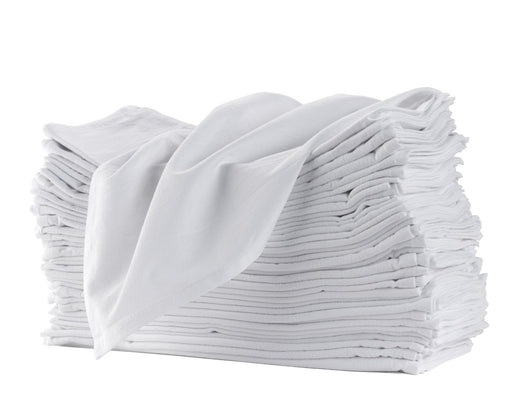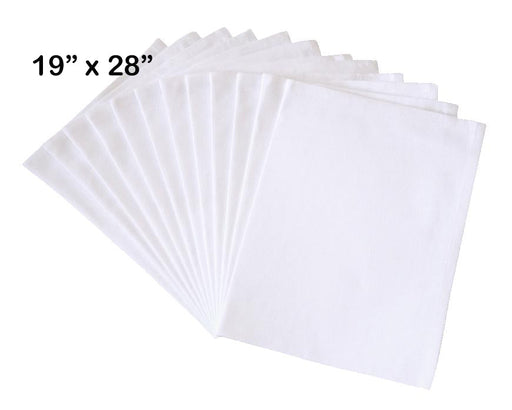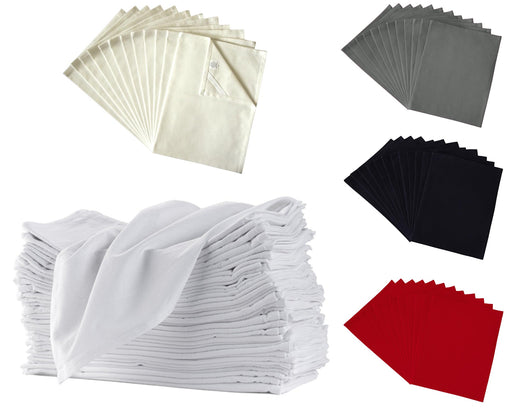Continental U.S. only.
Continental U.S. only.
Flour sack towels are one of the most versatile kitchen linens available. They are absorbent, so they can be used to dry dishes or to dry your hands. They are lint free, so they can be used to cover bread dough as it rises or to cover other baked goods as they cool.

When you use a basket for serving at the table or as a container for a gift basket of baked goods, flour sack tea towels make ideal basket liners. When presented as a gift basket, both the basket and the flour sack tea towel liner become additional gifts that the recipient can keep as a reminder of your thoughtfulness.
Because flour sack tea towels are made from soft, 100% cotton, they can be machine washed and dried. Since they can be so readily laundered, they can even be used as cloth napkins on the table.
Flour sack tea towels become more decorative when enhanced with embroidery, and the choice of the embroidered design can make a gift that includes flour sack tea towels more special and meaningful.
If you are going to have a flour sack tea towel for drying your hands or dishes hanging somewhere in your kitchen, why have a plain one when adding a design to it turns it from a merely utilitarian item into a decorative one that enhances your kitchen decor.
When you are going to use a flour sack tea towel as a basket liner for bread, rolls, or baked goods for your table or as a gift, then adding a decorative design enhances the beauty of your table decor or your gift presentation. The embroidery design you choose can add to the theme of a party or recreate a shared memory for a special occasion.
SHOP FLOUR SACK TOWELS NOW
A monogrammed design embroidered on flour sack tea towels that you are using as napkins on your table can set a more formal tone while a decorative design can encourage a casual, festive, or romantic mood.
Hand or machine embroidery is a quick, easy way to add a design to flour sack tea towels. The design you choose can depend on the intended use, your kitchen or table decor, the occasion, or the season. Vintage, redwork, toile, and light and airy designs are recommended.
Mary's Kitchen Flour Sack Towels are so economical, and embroidery is so quick and easy, that you can create decorative tea towels for as many different uses and occasions as you can imagine.

Materials Needed
★ Mary Kitchen Flour Sack Towels
★ Iron-on transfer or the materials needed to transfer a design to a towel per the instructions below
★ Embroidery hoop -- a 7" hoop is recommended
★ 6-strand embroidery floss in desired colors
★ Embroidery needles
★ Pins
★ Scissors
★ Iron and ironing board to transfer design
Hand Embroidery Instructions
1. Wash, dry, and press the tea towels.
2. If you are using an iron on transfer, pin it face down on the tea towel.
3. Press the iron-on transfer with a hot iron with no steam to transfer the design.
4. Place the tea towel in the embroidery hoop and stitch.
5. Machine wash and dry the towel on gentle cycle, and press on the wrong side to help the design stand out.
How to Transfer a Non-iron-on Transfer Design
If your design is not an iron-on transfer, you can transfer it by one of the following methods.
Heat Transfer Pens
To use a heat transfer pen with a symmetrical design or one you have printed so that the right and left sides are reversed:
1. Use the heat transfer pen to draw over the lines of the design with the front or right side of the design facing you.
2. Pin the design face down on the tea towel.
3. Use an iron to transfer the design.
To use a heat transfer pen when your design is not symmetrical or reversed:
1. Turn your design over.
2. Use the heat transfer pen to draw over the lines of the design with the back or wrong side of the design facing you.
3. Pin the design on the tea towel with the back of the design down.
4. Use an iron to transfer the design.

Water Soluble Pens
1. Tape the design to a window with a strong light.
2. Tape the tea towel over it.
3. Use a water soluble pen to trace the design onto the towel.
Carbon Transfer Paper
1. Place carbon transfer paper on top of the towel with the colored side down.
2. Place the design face up on top of the carbon paper.
3. Use straight pins to pin the design and the carbon paper to the towel.
4. Use a ballpoint pen to trace over the design several times to make sure the design transfers to the towel.
Hand Embroidery Stitching Tips
If your design does not have specific instructions, here are some tips.
★ Two good reference books that provide a variety of embroidery stitches are Hand Embroidery Stitches At-A-Glance: Carry-Along Reference Guide by Janice Vaine and Embroidery: A Step-by-step Guide to More Than 200 Stitches by DK. With these resources, you'll be able to select the stitches best suited to your design and to the way you want your hand-embroidered version to look.
★ Work with 20-inch strands of embroidery floss.
★ If your design is mostly an outline:
1. Decide which lines you want to emphasize and which lines you want to minimize, or consider which lines would be in the foreground and which would recede into the background in a three-dimensional version of the design.
2. Embroider the lines that you want to emphasize or the ones that would be in the foreground using four to six strands of embroidery floss.
3. Embroider the lines that you want to be finer or that you want to recede into the background using two or three strands of embroidery floss.
★ There are two basic stitches for outlining, the running stitch and the back stitch.
The running stitch creates a broken line. This is a good stitch to use if you are using more strands of embroidery floss so that the thicker line is not too overpowering. It is important to try to keep the length of many embroidery stitches even, but that is even more important with the outline stitch.
The backstitch creates a solid line that works well with two or three strands of embroidery floss.

Materials Needed
★Mary Kitchen Flour Sack Towels
★Medium weight (2.5 - 3 ounce) cutaway stabilizer
★Spray adhesive
★Embroidery hoop
★Scissors
Machine Embroidery Instructions
1. Wash, dry, and press the tea towels.
2. Select a design from your embroidery machine software.
3. Print two copies of the design, one to use as a template and one to use as a copy of the thread list.
4. Cut a piece of stabilizer for the back of the towel that is larger than your hoop.
5. Use temporary spray adhesive to attach the stabilizer to the back of the towel.
6. On the template, mark the center and the horizontal and vertical axis lines on the top, bottom, and sides of the template.
7. Place the template on the towel.
8. Align the axis lines on the template with the marks on the hoop.
9. Secure the template and the tea towel together with the hoop.
10. Make sure that the hoop holds the towel taut without stretching it.
11. Load the design into your embroidery machine.
12. Thread the machine with the first color suggested or the color of your choice.
13. Attach the hoop to the machine.
14. Using a size 11 or a 75/11 embroidery needle, position the needle in the center of the design and embroider the design.
15. When the machine indicates, change to the next thread.
16. When you are done embroidering, trim away the excess stabilizer leaving about 1/2" around the design.
17. Machine wash and dry the towel on gentle cycle, and press on the wrong side to help the design stand out.
Stitching Tips
★ Consider light and airy designs for lightweight tea towels.

A medium-weight cutaway stabilizer is the best choice for flour sack tea towels. It will be easier to line up your design, and it will puçker less.
Because of the weight of the fabric, light and airy embroidery designs are best suited for flour sack tea towels whether you are doing hand or machine embroidery. Vintage, redwork and toile designs are popular styles for these embroidered flour sack tea towels.
Here are some suggestions for books featuring hand embroidery patterns for tea towels.
★ Vintage Hand Embroidery Patterns More Sunbonnet Girls: 24 Authentic Vintage Designs by Vicki Becker
★ Redwork from The WORKBASKET: 100 Designs for Machine and Hand Embroidery by Rebecca Kemp Brent
★ Cross Stitch Motif Series 6: Kitchen: 180 New Cross Stitch Models by Maria Diaz
★ 500 Simply Charming Designs for Embroidery: Easy-to-Stitch Monograms and Motifs by LTD E & G Crafts Co.
★ Fancy Teapots Hand Embroidery Patterns by StitchX Embroidery
★ Retro Coffee Time Hand Embroidery Patterns by StitchX Embroidery
★ Fruit Squares Hand Embroidery Patterns by StitchX Embroidery
★ Folk Art Towels for Kitchen and Bath: Embroidery Patterns by Harriet Tew
★ Holiday Fun Hand Embroidery Patterns by StitchX Embroidery
★ Halloween Pumpkins Hand Embroidery Patterns by StitchX Embroidery
If you are interested in patterns for your embroidery machine, the list of books above should give you ideas for designs that you would like to create that are compatible with your embroidery machine.
Mary's Kitchen Flour Sack Tea Towels are high quality, thick, durable, long lasting, and designed with DIY projects in mind. Just like handiwork from the past, with Mary Kitchen Flour Sack Tea Towels, you will be able to pass down many of the prized special occasion napkins, basket liners, and other items that you create.
SHOP FLOUR SACK TOWELS NOW
Mary Kitchen Flour Sack Tea Towels are absorbent, lint-free, and made from 100 percent, soft cotton. They have a variety of uses in the kitchen and at the table, including drying dishes or hands; lining baskets of bread, rolls, or baked goods for the table or for gifts; and serving as napkins on the table. These uses are enhanced by hand or machine embroidered designs chosen to complement your decor, the season, or the occasion.
Keep a supply of Mary Kitchen Flour Sack Tea Towels on hand. Then, you can quickly implement an idea for a hand or machine embroidered tea towel for your own home or as a gift for any occasion.

If you need red, gray, blue or black color please click here. ★ Multipurpose, available white or natural colors (unbleached), matching, wholesale ...
View full details
Custom Printed Flour Sack Towels ★ Current Production Time: 3–4 Weeks WHOLESALE | RESELLERS | DESIGNERS ✅ Everyone is welcome to order! If you'r...
View full details
100% Cotton, comes in white (bleached) and natural (unbleached) color A uniform 19" x 28" rectangle, 130 thread count, flour sack napkins hemmed...
View full details
100% Cotton A uniform 27" x 27" square, 130 thread count, 3 oz each heavyweight flour sack dish towels and hemmed on all sides A corner loop for...
View full details
Attention Re-sellers, Wholesalers, and Designers: If you need to order more than 100 pieces, please contact us for our special wholesale pri...
View full details